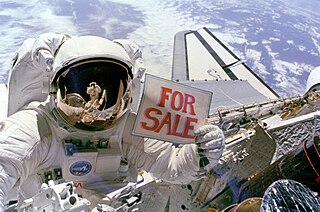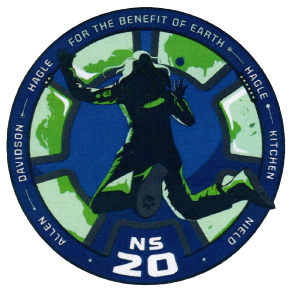Related Research Articles

Blue Origin Enterprises, L.P., commonly referred to as Blue Origin is an American aerospace manufacturer, defense contractor, launch service provider and space technologies company headquartered in Kent, Washington, United States. The company makes rocket engines for United Launch Alliance (ULA)'s Vulcan rocket and manufactures their own rockets, spacecraft, satellites, and heavy-lift launch vehicles. The company is the second provider of lunar lander services for NASA's Artemis program and was awarded a $3.4 billion contract. The company has four rocket engines in production including the BE-3U, BE-3PM, BE-4 and the BE-7.
New Shepard is a fully reusable sub-orbital launch vehicle developed for space tourism by Blue Origin. The vehicle is named after Alan Shepard, who became the first American to travel into space and the fifth person to walk on the Moon. The vehicle is capable of vertical takeoff and landings. Additionally, it is also capable of carrying humans and customer payloads into a sub-orbital trajectory.

A commercial astronaut is a person who has commanded, piloted, or served as an active crew member of a privately funded spacecraft. This is distinct from an otherwise non-government astronaut, for example Charlie Walker, who flies while representing a non-government corporation but with funding or training or both coming from government sources.
Corn Ranch, commonly referred to as Launch Site One (LSO), is a spaceport owned and operated by Blue Origin which is located approximately 30 miles north of the town of Van Horn, Texas, United States.
The BE-3 is a LH2/LOX rocket engine developed by Blue Origin.

The following is a timeline of important events in the history of private spaceflight, including important technical as well as legislative and political advances. Though the industry has its origins in the early 1960s, soon after the beginning of the Space Age, private companies did not begin conducting launches into space until the 1980s, and it was not until the 21st century that multiple companies began privately developing and operating launch vehicles and spacecraft in earnest.
New Glenn is a heavy-lift orbital launch vehicle in development by Blue Origin, named after NASA astronaut John Glenn, the first American astronaut to orbit Earth. Design work on the vehicle began in 2012; illustrations of the vehicle, and the high-level specifications, were initially publicly unveiled in September 2016. New Glenn is a two-stage rocket with a diameter of 7 m (23 ft). Its first stage will be powered by seven BE-4 engines that are also being designed and manufactured by Blue Origin.

The billionaire space race is the rivalry among entrepreneurs who have entered the space industry from other industries - particularly computing. This private spaceflight race involves sending privately developed rockets and vehicles to various destinations in space, often in response to government programs or to develop the space tourism sector.
Rocketplane Global Inc. is a reusable rocketplane aerospace design and development company incorporated in Delaware.

Robert E. "Rob" Meyerson is an American aerospace engineer and executive known for his role in the development of reusable rocket launch systems.
The private aerospace company Blue Origin has a number of development, manufacturing, and test facilities in four US states: Washington, Texas, Florida, and Alabama.

Blue Origin NS-16 was a sub-orbital spaceflight mission operated by Blue Origin which flew on 20 July 2021. The mission was the sixteenth flight of the company's New Shepard integrated launch vehicle and spacecraft, and its first crewed flight. It carried into space American billionaire and Blue Origin founder Jeff Bezos, his brother Mark, pilot and Mercury 13 member Wally Funk, and Dutch student Oliver Daemen. The flight commenced from Blue Origin's Corn Ranch sub-orbital launch site in West Texas aboard the third flight of New Shepard booster NS4 and the spacecraft RSS First Step, both having previously flown on NS-14 and NS-15 earlier in the year.

Virgin Galactic Unity 22 was a sub-orbital spaceflight of the SpaceShipTwo-class VSS Unity which launched on 11 July 2021. The crew consisted of pilots David Mackay and Michael Masucci as well as passengers Sirisha Bandla, Colin Bennett, Beth Moses, and Richard Branson.

Oliver Daemen is a Dutch space tourist who flew as part of the 20 July 2021, sub-orbital Blue Origin NS-16 spaceflight. At the time of his flight he was 18 years old, and became the youngest person, first teenager, and first person born in the 21st century to travel to space using the United States definition of the boundary of space. Daemen is a licensed pilot.
RSS First Step is a New Shepard space capsule, built and operated by American spaceflight company Blue Origin. It is the third New Shepard capsule to fly to space, and the first to fly passengers. Its first flight was the NS-14 mission, which reached an altitude of 107 km (66 mi) on 14 January 2021.

Blue Origin NS-18 was a sub-orbital spaceflight mission operated by Blue Origin that launched on 13 October 2021. The mission was the eighteenth flight of the company's New Shepard integrated launch vehicle and spacecraft. It was the second crewed New Shepard launch. The flight, carrying four people including actor William Shatner, launched from Blue Origin's sub-orbital launch site in West Texas aboard the fourth flight of New Shepard booster NS4 and the spacecraft RSS First Step, both having previously flown on NS-14, NS-15, and NS-16 earlier in the year.

Blue Origin NS-20 was a sub-orbital spaceflight mission operated by Blue Origin, which launched on 31 March 2022 using the New Shepard rocket. With six people on board, it was Blue Origin's fourth crewed flight, and twentieth flight overall to reach space.

Blue Origin NS-21 was a sub-orbital spaceflight mission, operated by Blue Origin, which launched on 4 June 2022 using the New Shepard rocket. It was Blue Origin's fifth crewed flight, and twenty-first overall to reach space.
Blue Origin NS-23 was an uncrewed sub-orbital spaceflight mission of Blue Origin's New Shepard rocket, which launched on 12 September 2022. The booster failed during max q about a minute after launch, triggering the launch escape system which removed the capsule from the booster. The capsule landed successfully, while the booster was destroyed upon impact with the ground.
Blue Origin NS-17 was an uncrewed sub-orbital spaceflight mission of Blue Origin's New Shepard rocket, which launched on 26 August 2021. It was New Shepards 4th flight in 2021. It was also Blue Origin's 17th overall flight to go into space.
References
- ↑ Sheetz, Michael (31 March 2022). “Jeff Bezos’ Blue Origin launches first New Shepard space crew of 2022”. CNBC. Retrieved 8 January 2023.
- 1 2 3 Boyle, Alan (29 October 2023). “Blue Origin’s chief architect lifts the veil on stealth moon startup at Pathfinder Awards”. Geekwire. Retrieved 11 November 2023.
- ↑ Wilensky, Joe (29 June 2022). “Blue Origin’s Gary Lai ’95 Rockets to (Suborbital) Space”. Cornellians. Retrieved 8 January 2023.
- ↑ “William E. Boeing Department of Aeronautics and Astronautics: Visiting Committee”. University of Washington. Retrieved 8 January 2023.
- ↑ “Patents Assigned to Kistler Aerospace Corporation”. Justia Patents. Retrieved 8 January 2023.
- ↑ “Blue Origin’s 20th Mission to Space”. Blue Origin. Retrieved 8 January 2023.
- ↑ Clark, Stephen (14 April 2021). “Blue Origin practices crew operations on suborbital test flight”. Spaceflight Now. Retrieved 8 January 2023.
- ↑ “How Blue Origin Will Keep Jeff Bezos and Team Safe”. youtube.com. Bloomberg Technology. Retrieved 8 January 2023.
- ↑ Sangal, Aditi and Crane, Rachel (20 July 2021). “How Safe Is the Blue Origin Rocket?”. CNN. Retrieved 8 January 2023.
- ↑ Davenport, Christian (18 July 2021). “Quiet and secretive Blue Origin hopes to start new chapter with Jeff Bezos’s space flight”. Washington Post. Retrieved 8 January 2023.
- ↑ “First Human Flight”. IMDb.com. Retrieved 8 January 2023.
- ↑ Pasquini, Marla (22 March 2022). “Blue Origin Is Replacing Pete Davidson with Company's Rocket Architect on Next Space Flight”. People. Retrieved 8 January 2023.
- ↑ Wall, Mike (28 March 2022). “Pete Davidson's spaceflight replacement is Blue Origin's Gary Lai”. Space.com. Retrieved 8 January 2023.
- ↑ Thorbecke, Catherine and Wattles, Jackie (28 March 2022) “Here’s who’s flying on Thursday’s Blue Origin space launch”. CNN Business. Retrieved 8 January 2023.
- ↑ “The Architect of New Shepard”. youtube.com. Blue Origin. Retrieved 8 January 2023.
- ↑ "External Advisory Board". Retrieved 5 September 2023.
- ↑ “2017 Stellar Award Winners”. RNASA. Retrieved 8 January 2023.
- ↑ “Blue Origin’s 20th Mission to Space”. Blue Origin. Retrieved 8 January 2023.
- ↑ "2023 Pathfinder Award Recipients". Aloft Magazine September-October 2023, pg. 25. Retrieved 5 September 2023.